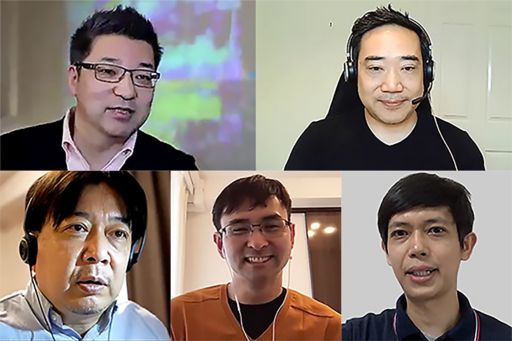It is not easy for a company to maintain its existing business and at the same time take on new challenges while ascertaining social trends. This is especially true when its existing business is “doing well.” What kind of thinking and elements are necessary for a company to pursue the essence of its own business and renew the very nature of the company itself?
We will introduce some discussions conducted on this issue between Masayuki Chatani of KPMG Ignition Tokyo and Kohei Terada, President & CEO of Warehouse TERRADA.
How Warehouse TERRADA Shifted to Top Niche Business
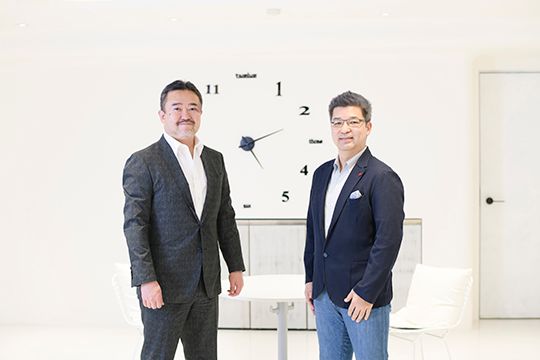
(Kohei Terada, President & CEO of Warehouse TERRADA (left), Masayuki Chatani, Representative Director & CEO of KPMG Ignition Tokyo and CDO of KPMG Japan (right)) *Professional affiliation and official position in the article are at the time of publication.
Chatani: There was a strong connection between my former company, Sony, and Warehouse TERRADA, which operates a warehousing business in the coastal area of Higashi Shinagawa, as it served as a hub for logistics and management of Sony’s parts for export. However, Warehouse TERRADA is now operating a wide range of businesses, which can hardly be expected of a warehouse company.
Your challenge to expand into other lines of business such as the wine storage service, which accepts storage from one bottle, storage of private art collections, museums and cafes, is attracting great attention. Looking at your recent activities, I get the impression that you are proactively trying to deal with things that are difficult to express with words. What made you take these actions?
Terada: I am the third CEO of Warehouse TERRADA. For about 30 years after its establishment, we were operating a warehouse business focusing on logistics. However, the image and appearance of the town gradually evolved in the 1960s. While the volume of logistics continued to increase, the aspect of economies of scale, led by strong and large-scale affiliated groups, was becoming clear.
My father had taken over the company as the second CEO at the time but he saw the changes and decided that he “wanted to evolve with a different business model rather than launching a strong offensive in the area of large-scale logistics.” This led to the decision to go into the retail business field. This is when the self-storage room business was starting to emerge.
In general, a self-storage room is seen as a room for tidying up private household belongings but the definition is a little different from the standpoint of a warehouse business. While a warehouse business handles products, a self-storage business handles non-products. It was during my father’s time that the company shifted to the BtoB business such as storing documents and video films for the TV industry.
Though each item that we store is extremely small, they become very big when gathered together collectively. Warehouse TERRADA now accounts for more than half of the major market share in the industry that handles these goods. However, it took 15 to 20 years for us to transform into this business model, which aspires to become a top niche company, and our conventional logistics business supported our revenue until then.
As Chatani-san just said, this business of storing works of art, bottles of wine, valuable goods and video media has come to attract a lot of attention in the past five to six years. But this business did not actually begin just recently. It began from around the mid-seventies and eventually became a matrix that creates huge revenue.
Discussed “What We Are Storing” before Investing in Digitalization
Chatani: It seems that the business transformation you implemented at a certain time is thriving today. In managing storage goods, can you tell us how you invested in digitalization and how you digitalized your existing business.
Terada: Digitalization has also been a trend in the past five to six years. In the world today, there is a trend to focus on SDGs and pursue what truly benefits customers but at Warehouse TERRADA, we have been discussing “what we are storing for customers” for about ten years.
Of course, what we are storing are bottles of wine, works of art and valuable goods. Meanwhile, these goods enhance their value with the passage of time. That’s why customers think that they are worth storing in an optimum environment. However, these goods that they are paying money to store are dead storage. This means that these goods are being hoarded without anyone knowing about them and that their value may be buried.
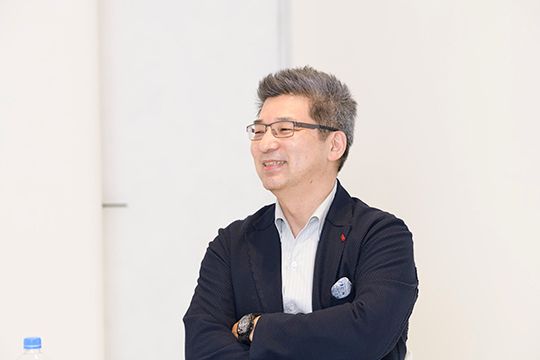
We then thought that “if they are valuable to customers, we must try to maximize their value.” This is how we came up with the idea to create a place to display them if necessary.
We therefore took photos of each item including works of art and bottles of wine and digitalized them so that they can be displayed on customers’ smartphones, tablets or PCs. By doing so, we were able to provide an added-value service that enables customers to know when the prices of their goods go up, when to sell them and to enjoy the value of their collections while storing them in an optimal environment.
In this context, the movement to “digitalize stored goods” has become the mainstream at our company in these past few years.
Digitalization Can Overcome “Barriers of Distance”
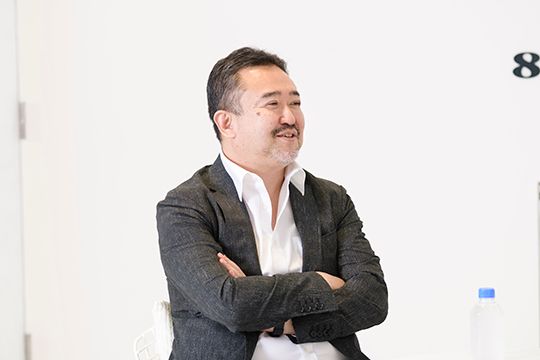
Chatani: By promoting digitalization, it feels like the service provided to customers is deepening from just “storing” to a non-verbal area.
Terada: In this regard, we were not storing wine for customers back then but only providing space while customers freely set the temperature and humidity as time passed by.
But now, we are taking photos of each bottle of wine we are storing so that customers can digitally organize their own collections and understand current market prices. This is the same for works of art.
Someday, we hope to operate a service where owners can trade their collections with each other. We are also thinking of creating a museum for exhibiting collections. We think that by creating a world without any barrier between analogue and digital, we will be able to provide solutions that are in the best interests of our customers.
Chatani: I see. I understand that what you talked about leads to the concept of your cloud storage service, “minikura,” which enables anyone to have their own warehouse starting with one box.
Terada: Thank you. Indeed, what made us shift to this direction was our service called “minikura.”
We were operating a self-storage facility which stores individual people’s household goods and when we reexamined this market, we realized that it was surprisingly expensive to rent a self-storage room located 1-2 kilometers from the city where people live.
When you want to rent a self-storage room near your house in the city, a mysterious phenomenon occurs where you have to pay a higher price per square meter than that of the condominium you are living in. This is because when we create a lot of self-storage rooms, we need a lot of facility space such as hallways.
People may suggest that “you should rent a larger house” but it is not so easy for home owners or those living in rental housing to move. The reason why the self-storage business is growing in the world is because “people have no other choice but to rent storage space even if it is somewhat expensive.”
However, the situation is quite different overseas. For instance, in the U.S., the self-storage business has grown to a market on a scale of 3.5–3.6 trillion yen. Why did the market grow so much, which is beyond comparison with Japan? When we carried out various studies, we found out something very simple.
As the metropolitan area is decentralized in the U.S., the price of land located 15 to 20 minutes by car from the metropolis drops considerably compared to rental rates at the center of a metropolis. It is not like in Japan, where land prices gradually drop from Tokyo toward suburbs like the shape of Mt. Fuji. In the U.S., they have 50 and 60 mountain peaks like a kenzan (spiky frog) and land prices in the valley areas are one-fifth of the peaks in some areas. That makes it worthwhile to rent a self-storage room, doesn’t it?
However, this is not the case in Japan. If we think of lowering the cost, it is better to store goods at a distant place but this will then entail transportation costs. Even if we can easily rent a storage space starting with one cardboard box, we tend to forget what we have stored. Even if we think of taking photos of what is inside the box before sending it, this will take a lot of trouble…
Chatani: The urban landscapes in Japan and the U.S. are certainly completely different. I can understand the difference between Japanese and U.S. cities from my experience of living in the U.S.
Terada: In view of these circumstances, we started the service called “minikura” to provide storage and also take photos for 330 yen per box. For us as well, we can absorb the cost if the cost of storage is low.
Like I said, “minikura” is the starting point of the current Warehouse TERRADA and our project started with the idea to “eliminate the barrier of distance.”
In the past ten years, we have continued to expand our service model, based on the idea to not hoard what we are storing, and we have implemented a multiplication business to fulfill the needs of customers, which involve more than “just storing goods.”
Took on Challenge of “Free to Play” Method to Let People Know about Service
Chatani: I am a wine expert qualified by the Japan Sommelier Association so I was looking at your wine storage service with great interest. You were recently running a campaign offering inexpensive but good wine from famous wineries. It seems that when the applicants in the campaign win a wine, they do not have to move the prize wines but can store them at Warehouse TERRADA. I thought it was quite interesting that you offered the experience of storing the wine as part of the prize rather than just delivering the wine to their homes.
I felt that this business model is quite similar to the concept of “free to play” games, which offer players the chance to enjoy a game in the hope that they will pay to play if they like it.
Terada: That campaign was like a “breaking ball” because what we were initially thinking of was wine bartering. As we are storing 350,000 bottles of wine, our initial intention was to create a platform where the owners can trade the wine they want with each other or a place where they can call out “I want this wine” like a reverse auction.
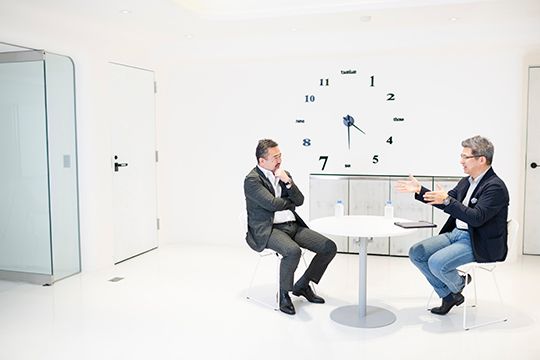
However, in the process of promoting this project, we came up against the obstacle that a license to sell alcoholic beverages had to be acquired. We concluded that this was difficult because it takes about half a year to get a license and would involve a significant cost for everyone to acquire one. Though we intend to work on breaking down this legal wall separately, it cannot be done in the immediate future.
This is when we changed our direction and considered handling wine ourselves. However, I must admit that I didn’t think that it would sell so well (laughs).
When we started the service in 2020, however, we were able to sell hundreds of million yen worth of wine in a surprisingly short period of time. This is how we ran the campaign you just mentioned, to offer a new experience to customers who newly purchased wine.
Chatani: In the U.S., there are often cases where collectors who can no longer drink wine sell their collections of 3,000 to 4,000 bottles of wine to other collectors, but Warehouse TERRADA is proposing a transaction method to “only transfer the right of ownership.”
Terada: Exactly. As bottles of wine also have a best-to-drink time of 20-50 years, how to maximize their value within this time frame is one of the concerns of collectors. I believe that our initiative to not just store them but add maximum significance to them will serve as an opportunity to create a new market.
Profile of Interviewee

Kohei Terada
President & CEO of Warehouse TERRADA
Kohei Terada joined Mitsubishi Corporation in 1993 after graduating from Keio University with a B.A. in law. He established Bit-isle Inc., a data center operating company, and became President in 2000. The company was listed on the Hercules Market of the Osaka Securities Exchange (currently JASDAQ Standard Market) in 2006 and the First Section of the Tokyo Stock Exchange in July 2013. After receiving a tender offer from U.S.-based Equinix Inc., the world’s leading data center company, Bit-isle was delisted in 2015 and Kohei Terada became COO & Director of Equinix Japan K.K.
In June 2018, he became President & Director of his family’s business, Warehouse TERRADA, and has served as President & CEO since June 2019. He is concurrently Chairman of the Japan Association of Corporate Executives and CO-WELL Co., Ltd., a leading offshore business in Vietnam, and an outside director at eBOOK Initiative Japan Co., Ltd. and MarketEnterprise Co., Ltd. As his personal investment destinations, he is also concurrently an advisor for various venture businesses including Mobcast Holdings Inc. and Allied Architects, Inc.
Follow us on KPMG Ignition Tokyo LinkedIn for the latest news.
Connect with us
- Find office locations kpmg.findOfficeLocations
- kpmg.emailUs
- Social media @ KPMG kpmg.socialMedia




